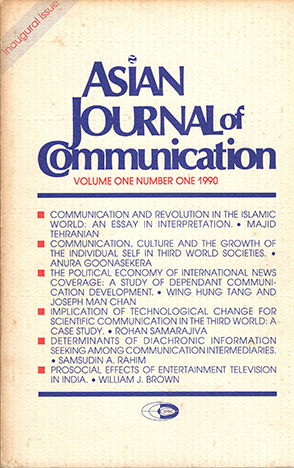About the Asian Journal of Communication

By Dr. Peng Hwa Ang, Editor
The Asian Journal of Communication is the flagship publication of AMIC. It was visionary venture by pioneering member Eddie Kuo and former research director of AMIC the late Anura Goonasekara.
From its very humble beginnings appearing twice a year from 1991, the Asian Journal of Communication now appears six times a year. It is co-published by AMIC and NTU. My University offers support in granting me as the editor a course waiver with a doctoral student as editorial assistant to handle administrative. The royalties go entirely to support AMIC.
The vision of the founding editors was for the Journal to be a voice of Asia in communication research. The mission is to publish academic research conducted rigorously but with an Asian perspective and an Asian voice. Manuscripts submitted must therefore have a link to Asia and advance theory in communication. So what types of work are outside the mission of the AJC. The following examples illustrate:
- Empirical works are outside the mission of the journal. A study on the landscape of traditional and online media, while important for many purposes, will be published only if there is some interesting finding.
- Replication of theories—using Asia as the source of data—would also be rejected. The research must advance theory in some way. Merely confirming a theory is not sufficient.
- Research that merely use Asia as the data source may be rejected. For example, if the manuscript discusses theory in such a way that it appears to be intended for an international audience, an international journal, as opposed to a “regional” such as the AJC, might be a more appropriate forum.
The focus on theory in recent years has meant that scholarly essays—the kind that do not use hypotheses testing—had been left out. Scholarship in Asia, notably in India and China—has always recognized such essays. This year, we have appointed a review editor to look at such qualitative works.
We think we are on the right track. All the indicators of greater reach and citations are pointing up. As Table 1 below shows, the impact factor has been rising.
Table 1: Impact Factor of the AJC
| 2019 | 2020 | 2021 | |
| Impact Factor | 0.743 | 1.839 | 2.074 |
| 5-Year IF | 0.982 | 1.817 | 1.963 |
Source: Clarivate, Journal Citation Reports 2020-2022
I suspect the rise may be due to the wider reach as we have promoted published articles through social media—specifically Facebook and Twitter—with the help of our social media editor.
More recently, we have had researchers approach us with ideas for special issues. Among them is the recently published one on freedom of expression; an earlier one touched on Covid. Other special issues in the works address anti-Asian racism (not just in the West but also in Asia) and Islamic communication research.
Next Issue: How to avoid the desk-reject of your submission to a journal
